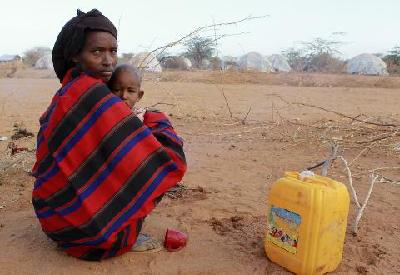
This is the VOA Special English Agriculture Report.
East Africa's drought is the worst in 60 years. Scientists say the dry conditions in the Horn of Africa are at least partly the result of an event half a world away.
The event is called La Nina, which means "little girl" in Spanish. A La Nina begins when waters become cooler than normal in the eastern Pacific Ocean near the equator. Changes in wind currents can then affect weather around the world. A related event, called an El Ninos, happens when the waters become unusually warm.
La Nina and El Ninos happen about every three to five years. The latest La Nina began in July of last year and ended in May. The conditions can last for up to two years.
Wassila Thiaw studies Africa for the Climate Prediction Center at the National Weather Service in the United States. With a La Nina, Mr. Thiaw says the easterly winds that are supposed to bring moisture into East Africa are reduced.
WASSILA THIAW: "There was less moisture coming into East Africa and therefore rainfall is reduced."
Starting late last year, rains that were supposed to fall over Somalia, southern Ethiopia and northern Kenya failed. That part of the Horn of Africa has a second rainy season from March through May. Mr. Thiaw says that one failed, too, but for different reasons.
WASSILA THAW: "What played out here during the March-April-May season we do not think that is really La Nina. But it [is] probably mostly due to the atmospheric conditions that prevailed at that time."
Mr. Thiaw says La Nina conditions might begin again by the end of this year. And if that happens, he says, then the October-through-December rainy season could again be dryer than normal.
Climate researcher Simon Mason at Columbia University in New York says East Africa has been getting drier over about the last ten years. Mr. Mason says this is at least partly the result of global warming. Rising temperatures in the Indian Ocean create conditions that pull moisture away from East Africa.
Claudia Ringler at the International Food Policy Research Institute also points to another issue. She said by Skype that much of the land in the drought-affected areas is not very productive even in good times.
CLAUDIA RINGLER: "It will not get any better. Even if we have a bit more rainfall, the general potential for more food production is not expected to improve dramatically in the region."
In the United States, the latest La Nina pushed moisture away from the south, causing severe droughts. Texas has suffered billions of dollars in agricultural losses. Changes in the winds pushed the rain toward northern states, causing floods.
And that's the VOA Special English Agriculture Report, written by Jerilyn Watson and Steve Baragona. To find transcripts and MP3s of our programs, or to post comments, visit our website voaspecialenglish.com. I'm Karen Leggett.
As drought intensifies, Kenya fears famine
Climate patterns can predict El Nino's arrival
(来源:VOA 编辑:崔旭燕)
